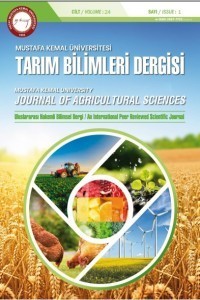Akdeniz koşullarında yüzey ve yüzeyaltı damla sulama yöntemi ile sulanan soya fasulyesinin sulama açığına tepkisinin taç sıcaklığı kullanılarak karşılaştırılması
İnfrared termometre, Glycine max, Kısıntılı sulama, Antalya, Yarı-kurak
Comparison of response of soybean irrigated by surface and subsurface drip irrigation method to deficit irrigation using canopy temperature under the Mediterranean conditions
Infrared Thermometry, Glycine max, Deficit irrigation, Antalya, Semi-Arid,
___
- Anda A, Simon B, Soós G, Teixeira da Silva JA, Kucserka T (2019) Crop-water relation and production of two soybean varieties under different water supplies. Theoretical and Applied Climatology 137, 1515–1528.
- ASAE (2001) Soil and water terminology. ASAE Standards 49th Ed S526.4, 903–907.
- Camp CR (1998) Subsurface drip irrigation: A review. Trans. Am. Soc. Agric. Eng. 1353–1367.
- Candogan BN, Sincik M, Buyukcangaz H, Demirtas C, Goksoy AT, Yazgan S (2013) Yield, quality and crop water stress index relationships for deficit-irrigated soybean [Glycine max (L.) Merr.] in sub-humid climatic conditions. Agricultural Water Management 118, 113–121.
- Candoğan BN, Yazgan S (2016) Yield and quality response of soybean to full and deficit irrigation at different growth stages under sub-humid climatic conditions,. Journal of Agricultural Sciences 22, 129–144.
- Evett SR, Howell TA, Schneider AD, Upchurch DR, Wanjura DF (2000) Automatic drip irrigation of corn and soybean. In Proc. 4th Decenn. Natl. Irrig. Symp, pp 401–408
- Hatfield JL (1990) Measuring plant stress with an infrared thermometer. Journal of Horticultural Science 25, 1535–1538.
- Idso SB, Jackson RD, Pinter PJ, Reginato RJ, Hatfield JL (1981) Normalizing the stress-degree-day parameter for environmental variability. Agricultural Meteorology 24, 45–55. doi:10.1016/0002-1571(81)90032-7.
- Irmak S, Specht JE, Odhiambo LO, Rees JM, Cassman KG (2014) Soybean yield, evapotranspiration, water productivity, and soil water extraction response to subsurface drip irrigation and fertigation. Transactions of the ASABE 57, 729–748.
- Jackson RD, Idso SB, Reginato RJ, Pinter PJ (1981) Canopy temperature as a crop water stress indicator. Water Resources Research 17, 113–1138.
- Kıllı F, Beycioğlu T (2019) Oil seeds and crude oil production in the world and Turkey, problems of oilseeds production in turkey. IJAAES International Journal of Anatolia Agricultural Engineering 1, 17–33.
- Lamm FR, Rogers DH, Alam M, Clark GA (2003) Design considerations for subsurface drip irrigation (SDI) Systems. Irrigation Management Series. Kansas State University Agricultural Experiment Station and Cooperative Extension Service: Kansas. pp 189-198.
- Nielsen DC (1990) Scheduling irrigations for soybeans with the Crop Water Stress Index (CWSI). Field Crops Research 23, 103–116.
- Ospanbayev ZHO, Kurmanbayeva MS, Abdukadirova ZHA, Doszhanova AS, Nazarbekova ST, Inelova ZA, Ablaikhanova NT, Kenenbayev SB, Musina AS (2017) Water use efficiency of rice and soybean under drip irrigation with mulch in the south-east of Kazakhstan. Biology Applied Ecology and Environmental Research 15, 1581–1603.
- Ozkara MM (1991) Second-crop soybean menemen region water sonsumption. Menemen Agricultural Research Institute Publications 170, 1–10.
- Payero JO, Irmak S (2006) Variable upper and lower crop water stress index baselines for corn and soybean. Irrigation Science 1, 31–32.
- Payero JO, Yonts CD, Irmak S, David TD (2005) Advantages and disadvantages of subsurface drip Irrigation. Historical materials from University of Nebraska–Lincoln Extension. pp 8.
- Phene CJ, Davis KR, Hutmacher RB, McCormick RL (1987) Advantages of Subsurface Irrigation for Processing Tomatoes. Acta Horticulturae 200, 101–113. doi:10.17660/actahortic.1987.200.9.
- Reich D, Godin R, Chavez JL, Broner I (2009) Subsurface drip irrigation-Crop Series No. 4.716. Colorado State University Extension. pp 3.
- Tekelioğlu B, Büyüktaş D, Baştuğ R, Karaca C, Aydinşakir K, Dinç N (2017) Use of Crop Water Stress Index for Irrigation Scheduling of Soybean in Mediterranean Conditions. Journal of Experimental Agriculture International 18, 1–8.
- TUİK (2020) Crop Production Statistics http://tuik.gov.tr/PreTablo.do?alt_id=1001. Ecce. Date of access: 22.10.2020.
- Yazar A, Howell TA, Dusek DA, Copeland KS (1999) Evaluation of crop water stress index for LEPA irrigated corn. Irrigation Science 18, 171–180.
- Yazar A, Oğuzer V, Tülücü K, Arıoğlu H, Gençoğlan C, Dıker K (1991) Developing irrigation scheduling for second crop soybean by taking advantage of open water surface (Class A Pan) evaporation under Harran conditions (In Turkish). GAP Kalkınma idaresi Başkanlığı Kesin Sonuç Raporu. 10p.
- Yayın Aralığı: Yılda 3 Sayı
- Başlangıç: 1996
- Yayıncı: Hatay Mustafa Kemal Üniversitesi
Olcay BOZDOĞAN, Yücel KARAMAN, Nihat TURSUN
İlknur KORKUTAL, Elman BAHAR, Serhan AZSÖZ
Tüketicilerin gıda güvenilirliği konusunda farkındalıkları: Konya ili kent merkezi örneği
Halime KELEŞ, Kübra DORUATLI, Mevlüt GÜL, Bektaş KADAKOĞLU
Uğur BİLGE, Kerim Mesut ÇİMRİN, Abdullah EREN
Hasan ÖZ, Cennet YAYLACI, İbrahim ERDAL
Oğuzhan ÇALIŞKAN, Derya KILIÇ, Safder BEYAZİT
Hatay ilindeki göletlerin hazne hacimlerinin coğrafi bilgi sistemleri ile belirlenmesi
